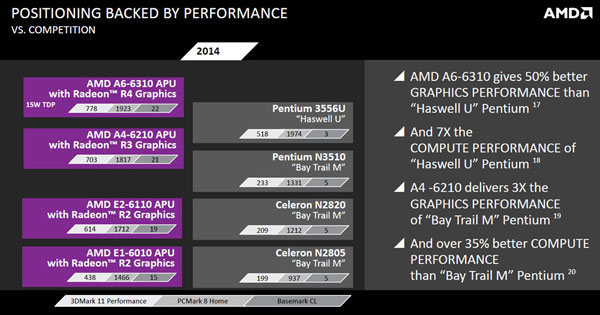Mullins And Beema APUs: AMD Gets Serious About Tablet SoCs
AMD recently introduced us to its Mullins and Beema APUs, which are architecturally similar to Kabini and Temash, but include some power and performance enhancements. We take an early look at a custom form factor and compare to Intel's best effort.
The Platform Security Processor, APU Models, And Market Positioning
AMD's updated low-power APUs are the first (and so far, only) x86 processors with an integrated ARM core. Dubbed the Platform Security Processor (PSP), this core is actually a 32-bit ARM Cortex-A5 with its own ROM and SRAM. The PSP is designed to provide a secure processing path, a trusted execution environment (TEE), a Trusted Platform Module (TPM), and a crypto co-processor capable of operating within ARM's TrustZone blanket of hardware-enabled security services.
At least on paper, the Platform Security Processor is an interesting IP add-on that we'd imagine stems from a desire to make mobile devices in the workplace easier to manage and control, since these aren't capabilities most home users want or need. AMD appears to be courting a segment currently under-serviced by existing ARM-based SoCs and Intel's own Bay Trail devices. However, it remains to be seen whether ISVs develop around the on-die hardware to expose its capabilities in software.
Models And Market Positioning
By now it's pretty clear what we're dealing with at the heart of AMD's newest mobile APUs. The following chart spells out how AMD is segmenting its Mullins-based models:
| Header Cell - Column 0 | Radeon Brand | SDP | TDP | CPU Cores | Max CPU Clock | L2 Cache | Shaders | Max GPU Clock | Memory |
|---|---|---|---|---|---|---|---|---|---|
| A10 Micro-6700T | R6 | 2.8 W | 4.5 W | 4 | 2.2 GHz | 2 MB | 128 | 500 MHz | DDR3L-1333 |
| A4 Micro-6400T | R3 | 2.8 W | 4.5 W | 4 | 1.6 GHz | 2 MB | 128 | 350 MHz | DDR3L-1333 |
| E1 Micro-6200T | R2 | 2.8 W | 3.95 W | 2 | 1.4 GHz | 1 MB | 128 | 300 MHz | DDR3L-1066 |
The TDP range is tight, hanging between 3.95 and 4.5 W. Further, AMD attaches an SDP rating of 2.8 W up and down the line-up, conveying the power use expected during normal activity. Both top-end versions are quad-core configurations, receiving A10 and A4 branding, but differentiated by the addition of Micro as a prefix to their model number. The lone dual-core SoC bears the E1 designation.
AMD takes a different tact with its graphics marketing, using R2, R3, and R6 to indicate performance at multiple clock rates, since all three options sport 128 shaders.
Clearly, AMD hopes that Mullins will compete against Bay Trail-T and the more powerful Haswell-Y processors. And although there aren't any products with AMD's hardware inside yet, we're going to be benchmarking the potential of A10 Micro-6700T in a passively-cooled reference-class tablet.
| Header Cell - Column 0 | Radeon Brand | TDP | CPU Cores | Max CPU Clock | L2 Cache | Shaders | Max GPU Clock | Memory |
|---|---|---|---|---|---|---|---|---|
| A6-6310 | R4 | 15 W | 4 | 2.4 GHz | 2 MB | 128 | 800 MHz | DDR3L-1866 |
| A4-6210 | R3 | 15 W | 4 | 1.8 GHz | 2 MB | 128 | 600 MHz | DDR3L-1600 |
| E2-6110 | R2 | 15 W | 4 | 1.5 GHz | 2 MB | 128 | 500 MHz | DDR3L-1600 |
| E1-6010 | R2 | 10 W | 2 | 1.35 GHz | 1 MB | 128 | 350 MHz | DDR3L-1333 |
The Beema-based parts have TDPs between 10 and 15 W. There aren't any SDP ratings; that's because SDP is reserved for devices designed with a touch-first usage model in mind, and those aren't what Beema will drop into.
Get Tom's Hardware's best news and in-depth reviews, straight to your inbox.
Again, most of the SoCs are quad-core configurations; just one, the E1-6010, is a dual-core SoC. As with the Mullins-based parts, branding of the Radeon engine depends on clock rate, since every model includes 128 shader cores.
AMD plans to pit Beema against Bay Trail-M and Haswell-U in low-power laptops. True performance comparisons will need to wait until the company is able to secure design wins. But nothing about the specs suggest the theoretical match-up is unbalanced.
What we do have to test is an A10 Micro-6700T-equipped reference tablet that AMD calls its Discovery tablet, which we'll look at on the next page.
Current page: The Platform Security Processor, APU Models, And Market Positioning
Prev Page Meet The Mullins And Beema Tablet APUs Next Page The Discovery PlatformDon Woligroski was a former senior hardware editor for Tom's Hardware. He has covered a wide range of PC hardware topics, including CPUs, GPUs, system building, and emerging technologies.



